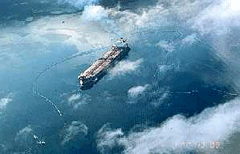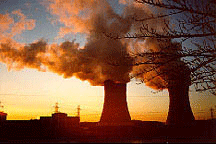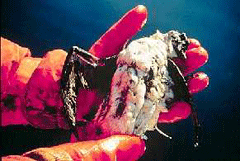Lessons learned from Exxon Valdez and Three Mile Island
Air Date: Week of March 27, 2009

On March 24, 1989, the oil tanker Exxon Valdez ran aground in Alaska's Prince William Sound, spilling 11 million gallons of oil. (Photo: Alaska State Archives)
Decades after two of the country's seminal environmental events, the accidents at Three Mile Island and Valdez still color the country's energy and environment debates. Host Bruce Gellerman and Washington correspondent Jeff Young talk about what lessons apply to today's discussion of nuclear power and oil.
Transcript
GELLERMAN: Well, almost exactly ten years to the day after the Three Mile Island melt down, on March 24th, 1989, the Exxon Valdez tanker went aground in Alaska spilling nearly eleven million gallons of crude into Prince William Sound.
Living on Earth’s Washington correspondent Jeff Young joins us to discuss the two environmental disasters. Hi Jeff!
YOUNG: Hi Bruce.
GELLERMAN: So here we are, thirty years after Three Mile Island and now there’s talk of a nuclear renaissance. Is that going to happen?
YOUNG: Well, you know, the melt down in question now is the economic melt down. The industry was predicting a dozen new reactors in the coming decade. Well, then the economy went south. Financing dried up. So analysts who look at the situation now say, we might see four, maybe eight, new reactors.
GELLERMAN: Hmm. But there are a lot more on the drawing boards, right?
YOUNG: In a paper sense, yes. But how many of those really get built is largely going to depend on the loan guarantees that the federal government is willing to put up for them. And I see another fight brewing in Congress over that – over whether to make more money available. Nuclear supporters here on Capitol Hill came very close to getting 50 billion dollars worth of loan guarantees in the economic stimulus bill, and they’re gonna try again as bills on energy and climate change take shape here in the coming months.

The cooling towers at Three Mile Island nuclear reactor.
GELLERMAN: Well, lets switch gears and look at the other environmental disaster anniversary – lessons learned from the Exxon Valdez disaster. I guess, the first lesson was that single hull tankers, like the Exxon ship, are not such a great idea.
YOUNG: Yeah. In the wake of the Valdez spill, the U.S. and 150 other countries agreed to phase out the single hulled tankers by the year 2015. And already about 80 percent of the world’s tanker fleet has been replaced with double hulled craft. And we got a reminder just this month of why that matters. A double hulled tanker hit a sunken oil rig in the Gulf of Mexico and there was no spill. However, there are still some companies that still use the single hulled tankers, and Bruce, you wanna take a guess as to which company uses the most of them?

Volunteer handles oil-soaked bird. (Photo: Alaska State Archives)
GELLERMAN: Jeff, you gotta be kidding.
YOUNG: That’s right. It’s Exxon Mobile.
[LAUGHING]
YOUNG: Bloomberg News Agency did some really good work looking at shipping records, and they found Exxon hired the most single hulled craft, by far. More than the next ten biggest companies combined.
GELLERMAN: So, why is Exxon still using them. Oh, let me guess – money?
YOUNG: Ding sing. Yeah. It’s about twenty percent cheaper. I called Robin Rorick, he’s a safety expert with the American Petroleum Institute to talk about this. And he says even with the single hulled tankers, overall safety is improving.
RORICK: There are plenty of single hulled tankers that are excellent tankers. It all depends on making sure that the tanker is seaworthy. The industry is certainly committed to making sure that they can operate in a manner that insures that the product can reach its destination. And to be quite frank – because any oil that reaches the environment is crude oil that can’t be sold.
YOUNG: Now maybe that’s, shall we say, crude motivation, but statistics back him up on that. The tanker industry has numbers that show that as the traffic went up over recent years, the number of major oil spills went down.
GELLERMAN: But aside from shipping, there’s another big part of the oil debate, and that’s off shore drilling.
YOUNG: Oh, absolutely. You recall that in the heat of the “drill, baby, drill” summer and four dollar a gallon gas, we lost the moratoria on offshore drilling. So the Obama administration is now in the midst of a review of what areas should be opened to oil, to gas and other energy development, like wind power or wave power. And we could get some preliminary reports from that review very soon, in just the next week or so. One of the first areas where we are likely to see an expansion of offshore drilling is in Alaska. There are leases for the far northern coast and a very controversial proposal to open part of the Bristol Bay of the Bering Sea.

On March 24, 1989, the oil tanker Exxon Valdez ran aground in Alaska's Prince William Sound, spilling 11 million gallons of oil. (Photo: Alaska State Archives)
GELLERMAN: Hmm. So how’s that playing with the folks up in Alaska?
YOUNG: Well, you know, petroleum is, of course, the state’s biggest industry, but fishing is also very important. And that’s something Keith Colburn came to Washington to remind Congress about. Colburn captains a crabbing boat in Bristol Bay. Maybe you saw him on television. He’s on the Discovery Channel program, “Deadliest Catch.” And when I caught up with him, Colburn was holding this big jar of dirty rocks.
COLBURN: Get this on the radio. Right there.
[SOUND OF JAR OPENNING]
YOUNG: Now, what’s in there?
COLBURN: These are rocks, cobbles, and a little bit of sand collected …
YOUNG: Oh man, I can smell it. That’s oil.
COLBURN: Yeah that is. That’s tar. That’s oil. That is – and that’s six inches below the surface in Prince William Sound. Eight percent of the oil was cleaned up. So, on the surface things look good. But below the surface, it’s completely different. I mean, not only in the inner tidal zones, but in the fisheries and fish stocks we still have, twenty years later, a lot of damage to the resources of that area. And the Bering Sea represents forty percent of the nation’s seafood products. Forty percent in one small area. And to put that at risk is a ludicrous idea.
YOUNG: Now next month the Interior Department which oversees offshore drilling is hosting four public hearings around the country on off shore energy. And one of those hearings, April 14th, is in Alaska, so people there will be able to share what lessons they think we should apply from the Valdez spill.
GELLERMAN: Well, not a happy anniversary by any stretch. Well, thanks a lot Jeff.
YOUNG: You’re welcome.
GELLERMAN: Jeff Young is Living on Earth’s Washington correspondent. And, by the way, Jeff has posted the schedule of those public hearings on our website at loe.org.
Links
Schedule of upcoming public hearings on offshore energy
Information from Dept. of Interior on proposed oil and gas leases in Alaskan waters
Statistics from the oil tanker industry on major oil spills over the years
Living on Earth wants to hear from you!
Living on Earth
62 Calef Highway, Suite 212
Lee, NH 03861
Telephone: 617-287-4121
E-mail: comments@loe.org
Newsletter [Click here]
Donate to Living on Earth!
Living on Earth is an independent media program and relies entirely on contributions from listeners and institutions supporting public service. Please donate now to preserve an independent environmental voice.
NewsletterLiving on Earth offers a weekly delivery of the show's rundown to your mailbox. Sign up for our newsletter today!
 Sailors For The Sea: Be the change you want to sea.
Sailors For The Sea: Be the change you want to sea.
 The Grantham Foundation for the Protection of the Environment: Committed to protecting and improving the health of the global environment.
The Grantham Foundation for the Protection of the Environment: Committed to protecting and improving the health of the global environment.
 Contribute to Living on Earth and receive, as our gift to you, an archival print of one of Mark Seth Lender's extraordinary wildlife photographs. Follow the link to see Mark's current collection of photographs.
Contribute to Living on Earth and receive, as our gift to you, an archival print of one of Mark Seth Lender's extraordinary wildlife photographs. Follow the link to see Mark's current collection of photographs.
 Buy a signed copy of Mark Seth Lender's book Smeagull the Seagull & support Living on Earth
Buy a signed copy of Mark Seth Lender's book Smeagull the Seagull & support Living on Earth

